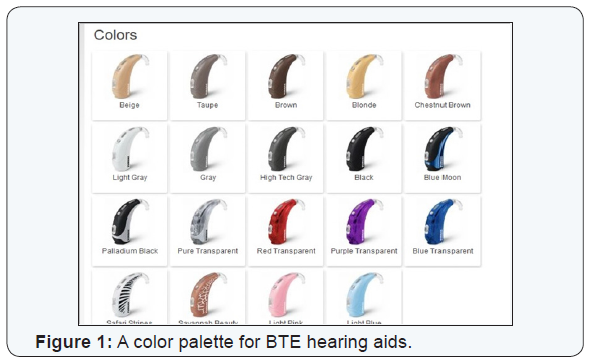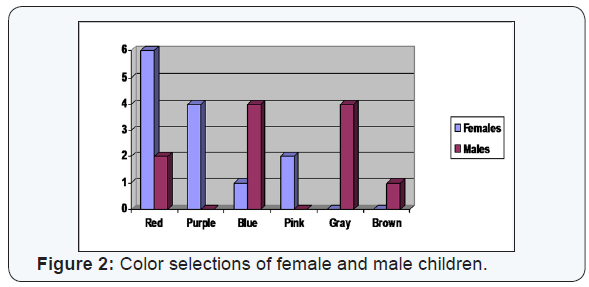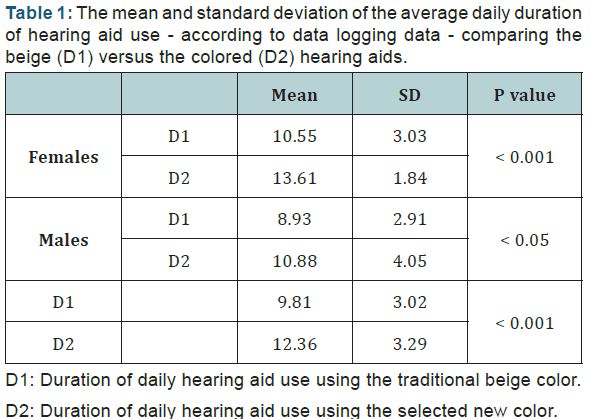The Effect of Hearing Aid Color on the Regularity of Hearing Aid Use in Children
Mohamed Abd Al-Ghaffar1 and Mohamed Wael Mohamed Mustafa2*
1Audiology and Vestibular Medicine Department, Sohag University, Egypt
2Audiology and Vestibular Medicine Department, South Valley University, Egypt
Submission: December 05, 2016; Published: December 15, 2016
*Corresponding author: Mohamed Wael Mohamed Mustafa, Audiology & Vestibular Medicine Department, Qena Faculty of Medicine, South Valley University, Qena, 83511 Egypt.
How to cite this article: Mohamed A A, Mohamed W M M. The Effect of Hearing Aid Color on the Regularity of Hearing Aid Use in Children. Glob J Oto 2016; 2(4): 555595. DOI: 10.19080/GJO.2016.02.555595
Abstract
Introduction: One major factor that plays a role in any child’s life is the color of his toothbrush, his shoes as well as his hearing aids. Therefore, this research was designed to monitor the effect of hearing aid color on the regularity of hearing aid use in children.
Method: Twenty-four children (13 females and 13 males) with severe to profound hearing loss participated in this study. Two children were excluded (two males) due to color blindness. They used traditional beige hearing aids for two month and colored hearing aids for more than two months. Data logging was used to assess the regularity of hearing aid use.
Results: Red and purple was preferred by female children while dark blue and gray were preferred by males but the majority of participants preferred red color. Children used their colored hearing aids for more time than their traditional beige devices (P < 0.01). Color, gender and age were the major factors that affected the regularity of use of hearing aids in those children.
Conclusion: Color of hearing aids can play a major role in assisting the regularity of use of hearing aids in young children.
Keywords: Hearing aids; Behind-the-ear; Color; Children; Regularity
Introduction
Children born with a permanent hearing loss run the risk of lifelong speech deficits and delays in the acquisition of language. Deficits in speech and language may result in poor academic performance, psycho-social difficulties, behavior and emotional problems [1]. Children have different requirements of their hearing. Several related but unique adult-child differences emerge from the literature [2]:
- Children are learning language, and do not have the capacity to “fill in the blanks” for sounds not audible in the way that adult listeners have.
- Children spend most of their time listening to the speech of other children and women, which has greater high frequency content than that of adult males. This places greater importance on providing audibility for the high-frequency cues of speech when providing hearing aids for the pediatric population.
- Children who use hearing aids must develop the ability to use information acquired while hearing amplified, processed sound. Children fit with hearing aids that fail to render audible the full set of speech cues are at risk of deficits in speech production and/or learning.
- Children have more demanding listening requirements than adults for understanding speech, particularly when the listening situation is difficult (low in level, noisy, and/or reverberant). Enhancement of audibility is required to support better speech understanding, either through increased level, increased signal-to-noise ratio, or improvement of the listening environment. Prescriptive targets for children may specify greater outputs in quiet environments than for adults. Strategies for hearing aid use in the classroom should include strategies or devices to address the effects of distance and reverberation.
- Children’s hearing aid use is typically mediated by a caregiver, at least through the early years of life. For this reason, issues of device use and monitoring, and caregiver training, are unique challenges in the pediatric population.
Most of these concerns will not be addressed if the child’s rejects the use of his hearing aids or uses them irregularly. One major factor that plays a role in any child’s life is the color of his toothbrush, his shoes as well as his hearing aids. Therefore, this research is designed to monitor the effect of hearing aid color on the regularity of hearing aid use in children.
Method
Twenty-six children (13 females and 13 males) with severe to profound hearing loss were selected for this study. Two children were excluded (two males) due to color blindness after being tested in the ophthalmology outpatient clinic. Thus, 24 cases continued the research (13 females and 11 males). Their age was ≥ 3 years old. They were fitted with two behind-the Ear (BTE) hearing aids with traditional beige color for 2 month. Data logging was used to assess the regularity of use of the hearing aids as an objective method. At the end of the second month, they were allowed to select the color of their hearing devices from a color palette (Figure 1). Their selections were respected sharply and they received their colored hearing aids within 10 days after selection. During these waiting days, hearing aid use was suspended. The new colored hearing aids were used for 2 further months. Data logging was used again to assess the regularity of use of the hearing devices. A simple query was done for the parents about their kids’ compliance. If the child rejected his hearing aids, this reaction was marked as a «dislike». If the child didn’t ask for wearing his hearing aids but accepted them when the parents put them on his ears, this was marked as a «borderline». If the child asked for wearing his hearing aids happily, this was marked as a «like».

Results
The number of hearing impaired children who participated in the study was 24 (13 females and 11 males). Their age ranged from 3 to 8.2 years (Mean = 4.35; Standard deviation = 1.28, Median = 4 and Mode = 4).
Discussion
Color is the bright site of childhood. Children adore colors and give a respond on it. However children’s response differs from adults’ reaction. If you are to communicate with children, color should become your ally. But you need to use the color language correctly. Children use limited palette, which becomes wider as they grow up. The age of the hearing- impaired children who participated in the study was mostly around 4 years. It is well known that Infants show color preferences by three months of age and color categorization by four months of age [3-6]. Additionally, a study conducted by Offenbach (1980) showed that the basic perceptual color space is invariant (from age 4 to old age) in normally sighted individual [7].
Conclusion

The majority of children preferred basic primary colors: red and blue (Figure 2). This is expected for children who are developing their color discrimination capabilities. Females preferred warm colors (red) while males preferred cool colors (blue). This agrees with the results of Ellis and Ficek (2001) who reported that males prefer blue. However, they demonstrated that females prefer green then blue [8]. Focusing on some of the actual mechanisms that may be involved in humans, research by Hoyenga and Wallace (1979) and McGuinness and Lewis (1976) found sex differences in retinal biochemistry and in how he brain processes color information. According to both studies, females seemed to be more sensitive to pinks, reds and yellows. In addition, the Hoyenga and Wallace study found that males looked to be more sensitive to colors in the blue-green color spectrum [9,10].

The duration of use of the colored hearing aids was significantly greater than the duration of use of the conventional beige hearing aids (Table 1). Moreover, the majority of cases shifted from the «dislike» and «borderline» reactions to the «like» attitude when colored hearing aids were used (Figure 3).
This marvelous reaction to color was actually unexpected for the same hearing aids with the same programming. When compared to other factors in a regression analysis, color was confirmed as the most important factor in determining the duration of hearing aid use (Table 2). The modern hearing aid technology of data logging helped monitoring the child’s attitude towards his hearing devices in a remarkable and objective manner. Using the color palette prior to hearing aid fitting in children proved to be an essential step for success of hearing aid fitting in children. Colored hearing aids help children use their hearing aids regularly and thus help the ultimate aim of development of speech and language in hearing impaired children.


References
- Yoshinaga-Itano C (2004) Levels of evidence: universal new born screening (UNHS) and early hearing detection and intervention systems (EHDI). J Commun Disord 37(5): 451- 465.
- American Academy of Audiology Clinical Practice Guidelines Pediatric Amplification. AAA Pediatric Amplification Guidelines 2013 Task Force.
- Thomasson MA, Teller DY (2000) Infant color vision: Sharp chromatic edges are not required for chromatic discrimination in 4-month-olds. Vision Res 40(9): 1051-1057.
- Teller DY, Peeples DR, Sekel M (1978) Discrimination of chromatic from white light by two-month-old human infants. Vision Res 18(1): 41-48.
- Adams RJ, Maurer D, Cashin HA (1990) The influence of stimulus size on newborns’ discrimination of chromatic from achromatic stimuli. Vision Res 30 (12): 2023-2030.
- Russell J Adams (1987) An evaluation of color preference in early infancy. Infant Behav Dev 10(2): 143-150.
- Offenbach SI (1980) Children’s percetion of Munsell Colors. J Psychol 104(1st half): 43-51.
- Lee Ellis, Christopher Ficek (2001) Color preferences according to gender and sexual orientation. Personality and Individual Differences 31(8): 1375-1379.
- McGuinness D, Lewis I (1976) Sex differences in visual persistence experiments on the Ganzfeld and after images. Perception 5(3): 295- 301.
- Hoyenga KB, Wallace B (1979) Sex differences in perception of auto kinetic movement of an after image. J Gen Psychol 100(1st half): 93- 101.





























